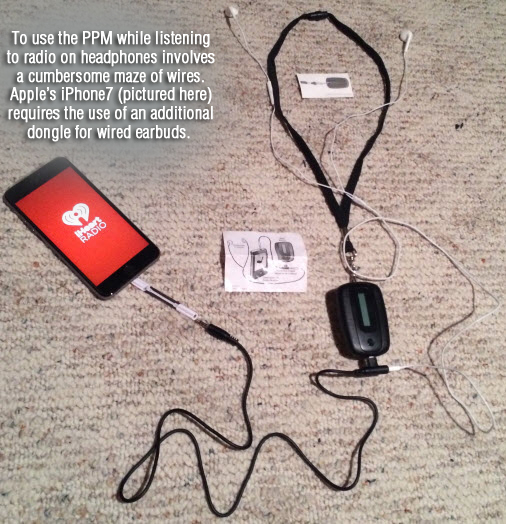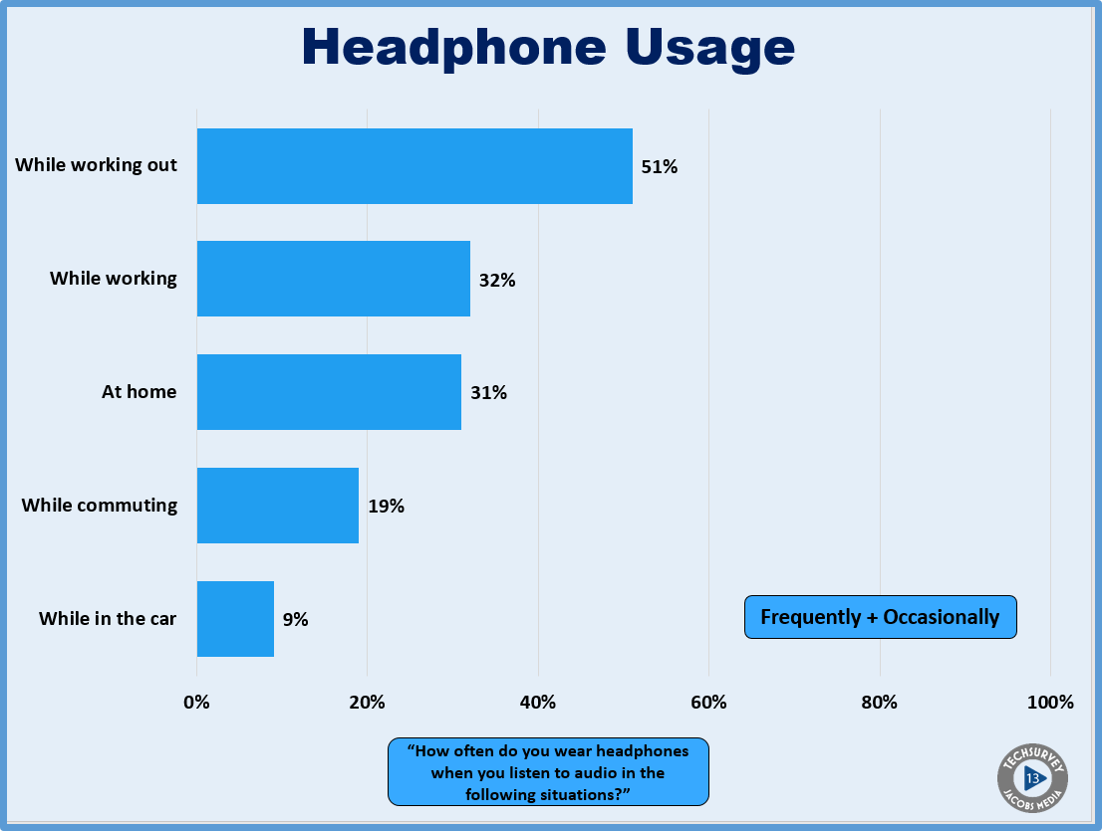
Just like how Congress reluctantly approaches tax reform, Social Security, and health care legislation and reform, the radio industry and its primary ratings service, Nielsen, periodically dust off the nagging headphone/earbud measurement issue.
And yesterday, it was back in the news, following the Alan Burns/Strategic Radio Solutions research study, “What Women Want – 2017.” It turns out a large percentage of women are using headphones while listening to the radio.
To reignite the issue, Paul Heine wrote two stories on the topic for Inside Radio – “Radio Wants Nielsen More Plugged In To Headphone Listening” and “Nielsen Defends Its Headphone Measurement Methodology.”
Nielsen insists that use of their special headphones dongle to capture this consumption is adequate, but Inside Radio quotes a 2013 Arbitron study suggesting serious compliance issues. And a number of Arbitron people off-handedly told me the same thing to me during those years.
Today, Nielsen explains how their dongle works to PPM panelists and encourages them to use it, but they don’t seem to know much about the degree to which it is used when their respondents don headphones or earbuds. As for the Media Ratings Council, they simply know the dongle technically works but lack information about whether meter holders are bothering with a cumbersome connector. The diagram at the beginning of this post was put together by consultant Randy Kabrich and it illustrates the tangled, wired mess of the dongle and the PPM meter.
Broadcasters deserve better. This situation is reminiscent of the “Cell Phone Only” conundrum that started more than a decade ago, and was eventually resolved by Arbitron in 2008. Our first Techsurvey played a starring role in that drama, along with then Arbitron exec, Dr. Ed Cohen, who helped come up with the ultimate solution. You can read our blog post about it here.
At the time, Arbitron wasn’t exactly excited to address – much less attack – the “Cell Phone Only” issue, but the trajectory of American homes dumping their landlines was persuasive enough for them to conclude they had a sample problem that was only going to worsen over time. They conducted considerable research along the way to better understand the extent to which “Cell Phone Only” homes were proliferating, and then came up with the answer.
And that’s precisely what Nielsen’s should be doing about the headphone question in 2017. Aside from not knowing precisely the extent to which their panelists make use of their headphone dongle, the societal move away from wire earbuds and headphones is accelerating, thanks in large part to Apple.
Their iPhone 7 – which has gone on to become their largest selling smartphone – has spurred the movement to wireless headphones because of their controversial decision to remove the headphone jack. And despite public outcry, nasty social media complaints, and other consumer pushback, the sale of wireless headphones is exploding. Not surprisingly, people want less wires in their lives – not more.
Not only are headphone sales continuing to grow, as the Inside Radio story points out, but Apple AirPods are ending up in more ears. A story in Ochen – “Critics be damned, Apple’s AirPods are dominating wireless headphone sales” – that ran just after the holidays reported an explosion of AirPods sales, despite the critics who suggested they would not be successful.
We saw evidence of this at CES back in January as Bluetooth wireless headphones and earbuds were everywhere. This is the way the technology and consumer electronics industries roll – Apple comes out with a new product (smartphone, tablet, etc.), and the peripheral and third party players create their own cottage industries.
Unreleased results from our upcoming Techsurvey13 back up the larger headphone usage trend. When it comes to a variety of listening environments, consumers wear headphones or earbuds a lot – especially while working out, on the job, or hanging out at home. Below is the percentage that use them frequently or occasionally while engaged in routine life activities:
 It is clear to observers of consumer electronics trends that the arc of audio consumption is moving away from a cumbersome, audio listening experience. Headphones and earbuds have become fashion statements for many. Yet, PPM’s need for a wired dongle runs counter to this cultural wave.
It is clear to observers of consumer electronics trends that the arc of audio consumption is moving away from a cumbersome, audio listening experience. Headphones and earbuds have become fashion statements for many. Yet, PPM’s need for a wired dongle runs counter to this cultural wave.
Nielsen would be wise to research the issue among its own panelists, rather than simply assume they’re complying or using other metrics to defend its methodology. And in the event their dongle turns out to be a boondoggle, it is incumbent on them to find a solution that ensures that panelist listening– whether it’s via broadcast or streams – is being accurately measured.
As I’m sure is the case with the Alan Burns/Strategic Radio Solutions study, we’ll make Techsurvey13 data available to the Advisory Council in the hope they’ll keep the pressure on Nielsen to address the problem, and if necessary, solve it.
Radio audience research needs to be as accurate and accountable as possible.
And the industry needs every quarter-hour it can get.
- What To Do If Your Radio Station Goes Through A Midlife Crisis - April 25, 2025
- A 2020 Lesson?It Could All Be Gone In A Flash - April 24, 2025
- How AI Can Give Radio Personalities More…PERSONALITY - April 23, 2025




NO more important issue in radio than accurate measurement! This dynamic should give EVERY broadcaster pause and we must demand accountability.
But, sadly likely won’t. #ifatreefalls?
Well done again Fred. Thx for trying to keep this vital issue visible.
Thanks, Dave. I know it’s not an easy task, but it is up to the industry to demand the best audience measurement affordable. And if it falls short, broadcasters need to know where, when, and why. Appreciate the comment.
Fred, another in a looooong line of justifiable quality issues with Nielsen / Arbitron. However: What incentive does Nielsen have to improve the methodology? Radio groups still pay huge $$ for subscriptions and Nielsen enjoys an unchallenged monopoly on ratings. So long as radio’s psychological addiction for continuous evaluation is in need of a jolt of endorphins, Nielsen will remain the drug of choice. Families, friends and the ability to test new formats will continue to be uprooted and abandoned by this dependency. The responsibility for radio’s value proposition and brand strength is not Nielsen’s…it’s ours.
Naïve as it may sound, Nielsen is in the business of serving its clients and providing the most accurate research it can – period. I would hope that would be enough incentive. But it’s up to Nielsen’s clients – broadcasters – to demand these deliverables. Simplistic? Maybe, but those should be their guiding principles. Thanks, Jim.